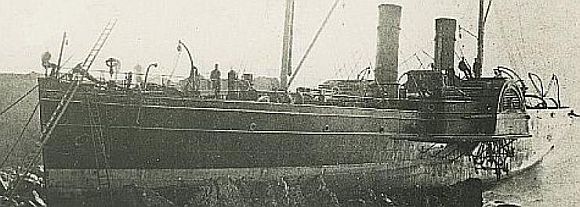 The Confederate blockade runner Agnes E. Fry is believed to have been located off Oak Island, North Carolina. She is one of three blockade runners lost in the area during the Civil War, but the only ship longer than 200 feet. The Agnes E. Fry was a 559-ton iron side-wheel steamer built by Caird & Company at Greenock, on the River Clyde in 19864. The blockade runner was 237 feet long by 25 feet in beam, with a depth of hold of 13 feet. She made two successful runs into Wilmington before being lost on her third attempted voyage, two days after Christmas 1864.
The Confederate blockade runner Agnes E. Fry is believed to have been located off Oak Island, North Carolina. She is one of three blockade runners lost in the area during the Civil War, but the only ship longer than 200 feet. The Agnes E. Fry was a 559-ton iron side-wheel steamer built by Caird & Company at Greenock, on the River Clyde in 19864. The blockade runner was 237 feet long by 25 feet in beam, with a depth of hold of 13 feet. She made two successful runs into Wilmington before being lost on her third attempted voyage, two days after Christmas 1864.
As reported by the North Carolina Natural and Cultural Resources website: “The location is right. The size is right. The correct pieces of the vessel are missing. These are contributing facts that lead archaeologists with the N.C. Office of State Archaeology to suspect that a shipwreck recorded Sat., Feb. 27, just off Oak Island is the blockade runner The location is right. The size is right. The correct pieces of the vessel are missing. These are contributing facts that lead archaeologists with the N.C. Office of State Archaeology to suspect that a shipwreck recorded Sat., Feb. 27, just off Oak Island is the blockade runner Agnes E. Fry, one of three Civil War shipwrecks thought to be in the area. A more sophisticated 3D sonar device will soon come to the aid of the underwater researchers, thanks to the Charlotte Fire Department, to help to confirm this boat’s identity.”
The Agnes E. Fry is named after the wife of her captain, Confederate Navy Lieutenant Joseph Fry, who would later become famous as a blockade runner during the Cuban Ten Year’s War for independence from Spain. He briefly became captain of Virginius, a small, high-speed side-wheel steamer hired by Cuban insurrectionists to run arms and men to Cuba. Fry became captain in early October of 1873. The ship was captured by Spain in on October 30. On November 7, 37 crew members, including Captain Fry, were executed by firing squad as pirates. Ultimately, in what became known as the Virginius Affair, a total of 53 of the crew were executed.
The Virginius affair is credited with indirectly prompting a surge in naval construction in the United States:
“When the Virginius affair first broke out, a Spanish ironclad, the Arapiles, happened to be anchored in New York Harbor for repairs, leading to the uncomfortable realization on the part of the U.S. Navy that it had no ship capable of defeating such a vessel. U.S. Secretary of War George M. Robeson believed a U.S. naval resurgence was necessary and Congress hastily issued contracts for the construction of five new ironclads, and accelerated its existing repair program for several more. USS Puritan and the four Amphitrite-class monitors were subsequently built as a result of the Virginius war scare. All five vessels would later take part in the Spanish–American War of 1898.“
